
Epipremnum aureum is a species in the arum family Araceae, native to Mo'orea in the Society Islands of French Polynesia. The species is a popular houseplant in temperate regions but has also become naturalised in tropical and sub-tropical forests worldwide, including northern South Africa, Australia, Southeast Asia, South Asia, the Pacific Islands and the West Indies, where it has caused severe ecological damage in some cases.

Thalictrum is a genus of 120-200 species of herbaceous perennial flowering plants in the buttercup family, Ranunculaceae, native mostly to temperate regions. Meadow-rue is a common name for plants in this genus.

The setaceous Hebrew character is a moth of the family Noctuidae. The species was first described by Carl Linnaeus in his 1758 10th edition of Systema Naturae. It is found in the Palearctic realm. It is a common species throughout Europe and North Asia and Central Asia, South Asia, China, Japan and Korea. It is also found in North America, from coast to coast across Canada and the northern United States to western Alaska. It occurs in the Rocky Mountains from Montana to southern Arizona and New Mexico. In the east, it ranges from Maine to North Carolina. It has recently been recorded in Tennessee.

Trifolium aureum, known by the various common names large hop trefoil, large trefoil, large hop clover, golden clover or hop clover, is a species of flowering plant native to much of Eurasia.

Plusiinae is a smallish subfamily of the moth family Noctuidae. As the Noctuidae appear to be a paraphyletic assemblage, the Plusiinae may eventually be raised to family status.

Ethmia pyrausta is a moth of the family Depressariidae. It is found in northern Scandinavia and adjacent Russia, as well as in China and Mongolia. The species is sometimes referred to as being "mythical", because it is so rarely encountered outside its remote native range. It is scarce resident in the UK and also found occasionally in other areas in Northern Europe.

Zygaena exulans, the mountain burnet or Scotch burnet, is a moth of the family Zygaenidae.
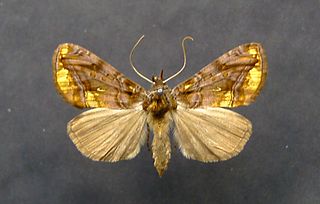
Lamprotes is a genus of moths of the family Noctuidae.

Euchalcia variabilis, the purple-shaded gem, is a moth of the family Noctuidae.
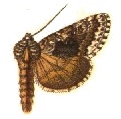
Syngrapha u-aureum, the golden looper moth, is a moth of the family Noctuidae. It is found from eastern Manitoba to Quebec, Labrador, southern Greenland, Newfoundland, northern Maine, northern New Hampshire and northern New York.
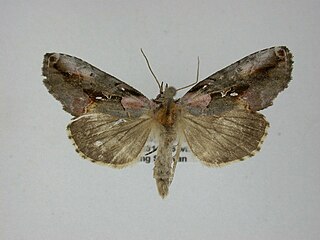
Eosphoropteryx thyatyroides, the pink-patched looper moth or pink-tinted beauty, is a moth of the family Noctuidae. The species was first described by Achille Guenée in 1852. In North America it is found from Nova Scotia and northern Ontario south to Minnesota, Michigan, Ohio and along the Appalachians from Maine to eastern Tennessee and western North Carolina; and to the west, it occurs from central Alberta and southern British Columbia, south in the Cascades to southern Oregon, and in the Rocky Mountains to northern Idaho.
Melaporphyria immortua, the dark-banded flower gem, is a moth of the family Noctuidae. The species was first described by Augustus Radcliffe Grote in 1874. It is found in North America from New England west to Colorado, north to southern Manitoba, central Saskatchewan and Alberta.

Thalictrum flavum, known by the common names common meadow-rue, poor man's rhubarb, and yellow meadow-rue, is a flowering plant species in the family Ranunculaceae. It is a native to Caucasus and Russia (Siberia). Growing to 100 cm (39 in) tall by 45 cm (18 in) broad, it is an herbaceous perennial producing clusters of fluffy yellow fragrant flowers in summer.

Eupithecia actaeata is a Eurasian species of moth of the family Geometridae.
The meadow rue borer is a species of moth of the family Noctuidae. It is found in the north-eastern United States and southern Canada east of the Rocky Mountains.
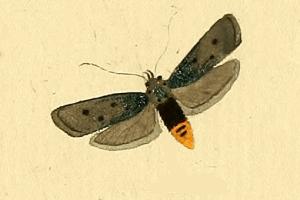
Ethmia aurifluella is a moth in the family Depressariidae. It is found in Morocco, Asia Minor, Syria, Iran, the Iberian Peninsula, France, Switzerland, Austria, Italy, Albania, North Macedonia, Bulgaria, Greece, Turkey, Romania, Ukraine and southern Russia.
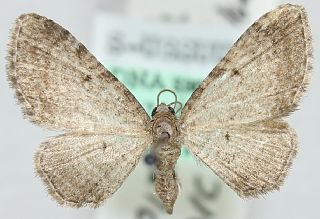
Eupithecia addictata is a moth in the family Geometridae. It is found from north-eastern Italy, through Austria, northern Hungary and southern Slovakia to Ukraine, Russia and Japan. It is also found in the southern Balkan Peninsula.

Pandemis dumetana is a species of moth of the family Tortricidae. It is found in China, South Korea, Japan, Russia, northern India, almost all of Europe, Asia Minor, Iran, southern Siberia and Transcaucasia. The habitat consists of woodlands, fruit farms, orchards and gardens.

Panchrysia aurea is a moth of the family Noctuidae. It is found in southern Europe and western and central Asia. The range extends from Portugal, east to Tian Shan, the Altai and the north-western Himalayas. In central Europe, it is found in the southern Alps, lower Austria and the mountains on the Balkan Peninsula.

Plusidia cheiranthi is a moth of the family Noctuidae. It is found in Southern and Eastern Europe, in Turkey, Siberia and eastwards to the Pacific Ocean.
















